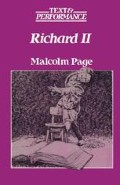Abstract
Studying recent productions of Richard II leads to the following conditions :
-
1.
Richard is inescapably the key character. Compared with Hamlet (as he has been since W. B. Yeats called him ‘an unripened Hamlet’), scope for different approaches is very limited. In recent years to the poet-king were added the actor-king, very aware of playing a role to an audience, and the philosopher-king, accepting loss of the throne and gaining self-knowledge in prison.
-
2.
New attempts have been made to give Bolingbroke almost as much importance as Richard, e.g. added lines in 1973; attention focused on the part in 1973 and 1979.
-
3.
Bolingbroke shown to be stressed, tired, ageing, unhappy once he is king.
-
4.
Attempts to find hidden depths in such other parts as York, Aumerle, the Queen and the Duchess of Gloucester have scarcely succeeded. Northumberland as a sinister power- behind-the-throne has, however, added new weight to this part.
-
5.
When Richard II is interpreted as the first of a series of four histories, Richard’s fall leads directly to later disasters and represents the end of the Middle Ages. This approach gives added importance to Northumberland and perhaps to Percy and the Welsh Captain (if he is Glendower of Henry IV).
-
6.
New thinking (e.g. on the King’s two bodies and on the work as self-consciously a theatre piece) influences directorial thinking and may be reflected in performance.
-
7.
The political dimension — the nature of rulers and the justification of rebellion — has had new attention, reacting against the subject being merely the tragedy of the poet-king. This presents difficulties, as monarchs are not prominent in late 20th-century political thought and divine right is a wholly alien concept.
-
8.
Stress on ritual, formality, even ‘the mass’, as in the gold-robed figures like brasses on tombs in 1980 and the stark sets of 1973 and 1979.
Copyright information
© 1987 Malcolm Page
About this chapter
Cite this chapter
Page, M. (1987). Conclusion. In: Richard II. Text and Performance. Palgrave, London. https://doi.org/10.1007/978-1-349-08144-8_11
Download citation
DOI: https://doi.org/10.1007/978-1-349-08144-8_11
Publisher Name: Palgrave, London
Print ISBN: 978-1-349-08146-2
Online ISBN: 978-1-349-08144-8
eBook Packages: Palgrave Literature & Performing Arts CollectionLiterature, Cultural and Media Studies (R0)

